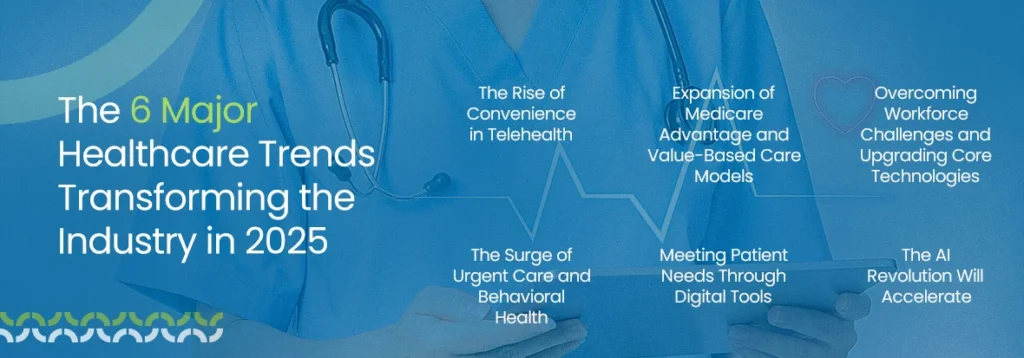The new year brings fresh opportunities and challenges for the healthcare industry. To stay competitive in 2025, medical practices and healthcare organizations must understand emerging trends and shifts to avoid falling behind. Being informed can help tackle key issues like provider burnout, administrative overload, patient loss, unmet quality standards for VBC programs, and other common hurdles.
Here’s a quick guide to keep you updated on the most important trends to watch in 2025.
2024 Set the Stage; 2025 Brings the Action
Before we look ahead, let’s briefly review the key shifts in healthcare during 2024.
Last year brought updates to Medicare Advantage and Part D, advancements in EHR software, expanded use of AI in healthcare, and a continued decline in the healthcare workforce. It was also an election year, shaping priorities for the industry.
In 2025, many of these trends will persist. The healthcare sector is projected to face a shortage of 200,000–450,000 registered nurses, leaving a 10–20% workforce gap. This shortage will push the industry to adapt, focusing on sustainable solutions to help practices operate with fewer resources.
As a result, 2025 is set to be a pivotal year for healthcare IT, with organizations turning to innovative technologies to address provider burnout and rising care costs.
The 6 Major Healthcare Trends Transforming the Industry in 2025

Now, let’s discuss the 2025 physician trends in business and what you, as a provider, need to know about them to successfully adapt and position your organization for long-term growth and improved patient care.
The Rise of Convenience in Telehealth
Consumers increasingly value healthcare services that offer flexibility, including digital options they can access from home, outside the standard nine-to-five clinic hours. To cater to this demand, healthcare systems should expand virtual care offerings, consider evening and weekend clinic hours, and explore alternative care sites. These approaches not only enhance convenience but can also reduce costs related to transportation and lost work time.
According to Deloitte 2024 US Health Care Consumer Survey, 64% of patients find virtual visits more convenient, making it their preferred choice over in-person care. To encourage wider adoption of telehealth, healthcare providers must address challenges such as limited broadband access, unfamiliarity with technology, and the need for private spaces to conduct virtual appointments. Tailoring solutions to the specific needs of different populations can ensure telehealth becomes a viable and accessible option for all.
Expansion of Medicare Advantage and Value-Based Care Models
In 2025, Medicare Advantage (MA) enrollment is expected to grow, continuing a trend despite recent challenges like changes to star ratings. Along with this growth, value-based care (VBC) models will see significant expansion. By 2027, around 90 million people are projected to be part of VBC models, which focus on improving care quality while managing costs. This shift is helping healthcare organizations gain more financial stability.
As more providers embrace VBC, the need for better integration between Electronic Medical Records (EMRs) and Health Information Technology (HIT) systems will increase. Providers will need a more complete and accurate view of patient data to improve care and meet quality standards. In addition, focusing on better risk-coding and ensuring referrals to high-quality providers will be essential for success. Overall, 2025 will see a stronger push toward adopting VBC and alternative payment models, which will improve both financial security and patient care outcomes.
Avoid Out-of-Network billing headaches & leave it to Professional Billers!
Overcoming Workforce Challenges and Upgrading Core Technologies
More than half (58%) of health system executives expect workforce challenges, including talent shortages, upskilling needs, and retention issues, to influence their strategies in 2025. While these challenges remain a top concern, they are less urgent compared to two years ago, when 85% of executives reported similar issues during a significant loss of clinical staff, as highlighted in previous Deloitte US health care outlook surveys.
Despite this decline in urgency, many health systems still face clinician shortages, burnout, and increasing labor costs. In medical billing, these challenges present an opportunity for leaders to rebuild trust, restore a sense of purpose for employees, and strengthen retention efforts. Here’s how healthcare providers can cope up with these challenges:
Shaping Teams for the Future of Healthcare
Redesigning work teams can help employees feel more connected to the organization and recognize the value of their roles. Health systems can create interdisciplinary care teams, offer tailored training programs, and outline clear career growth opportunities. Outsourcing medical billing services is also a practical option to reduce staff workload and improve efficiency.
Invest in Cost-effective Technologies
The Deloitte workforce technology study shows that AI and automation can reduce the time revenue-cycle staff spend on routine tasks by half and give nurses 20% more time for direct patient care.
The Surge of Urgent Care and Behavioral Health
As patient needs and care delivery change, some specialties will grow by meeting patients where they are. In 2025, we expect to see growth in specialties like urgent care and behavioral health, which have seen increasing demand in recent years.
Urgent Care
There are over 14,000 urgent care centers in the U.S., with a growth rate of 7%. Following the COVID-19 pandemic, patients continue to seek faster, more convenient access to care — especially when it’s difficult to see a primary care provider (PCP) or a specialist, or when care is needed outside regular business hours. Urgent care centers have proven valuable for treating non-emergency injuries and health issues, helping to reduce ER visits. It’s estimated that urgent care centers prevent around 24.5 million ER visits annually, saving patients time and money. Given current trends, we expect demand for urgent care facilities to keep growing in 2025.
Behavioral Health
Mental health awareness and access to behavioral health services have gained significant attention in recent years. By 2027, about 25% of the U.S. population is expected to use behavioral health services. Remote therapy and virtual counseling have also become more common since the pandemic, improving access to mental health care. With the stigma around mental health decreasing and a deeper understanding of mental health issues, behavioral health practices are set to expand in 2025. We anticipate a rise in new behavioral health practices, along with established ones adopting advanced health IT tools and electronic health records (EHR) to better manage growing patient needs.
Meeting Patient Needs Through Digital Tools
There is a strong demand for digital healthcare tools, patient portals, and self-service options. Over 75% of patients believe digital tools enhance their healthcare experience. These tools, such as messaging providers or self-scheduling, provide clear value to patients. Additionally, digital engagement improves communication, patient care, payment collection, and reduces administrative work for providers.
However, not all digital tools will see equal growth in 2025. While telehealth use will continue to rise, it will likely be most prominent in specialties like women’s health and behavioral health, where digital engagement is already high.
Studies show that providers with higher patient digital engagement see better financial outcomes, such as increased patient payments, quicker encounter closures, and reduced charge entry delays. This highlights the financial benefits for healthcare organizations that embrace digital tools. In 2025, we expect more practices to invest in expanding patient access to digital tools and self-service options.
As patient engagement becomes even more crucial in value-based care, demand for innovative and user-friendly digital tools will likely grow in 2025 and beyond.
The AI Revolution Will Accelerate
The increasing use of AI in healthcare offers promising solutions to several challenges faced by physicians, including reducing burnout, streamlining administrative tasks, improving patient communication, and enhancing diagnostic accuracy. Currently, around 28% of medical groups use AI-driven technology, such as ambient AI for transcription and note drafting. These tools help providers save time, allowing them to focus more on patient care and other essential tasks.
As AI investment in healthcare continues to grow, it is projected to increase from $20 billion in 2024 to $150 billion in the next five years. In 2025, we can expect to see a further expansion of AI-supported clinical documentation and patient communication tools. Along with this, new use cases will emerge, with organizations exploring AI applications aimed at saving time and strengthening data analytics capabilities.
Mainstream practice management software vendors, including Maxmius and Advanced MD, are also ramping up their AI integration initiatives, which will further shape the future of healthcare. We expect more healthcare organizations to adopt AI for clinical decision support and machine learning to analyze complex data sets such as imaging scans and lab results. Beyond 2025, AI could enhance patient-provider interactions by creating personalized care plans and improving follow-up care.
However, data privacy and security remain key concerns when integrating AI and machine learning into healthcare systems, particularly in relation to HIPAA compliance. Healthcare organizations will need to ensure the protection of patient data, likely by using private AI integrations. Additionally, determining the most effective AI applications and ensuring they meet quality standards while managing risks will continue to be a challenge.
A 3-Stage Roadmap for Implementing Healthcare Trends in 2025
| Trend | Stage 1 | Stage 2 | Stage 3 |
| The Rise of Telehealth | Expand virtual care offerings and increase accessibility | Overcome broadband access, technology familiarity issues | Integrate telehealth into regular care models for smooth access |
| Expansion of Medicare Advantage and VBC Models | Invest in technology for data integration and management | Enhance risk-coding, referrals, and care coordination | Nurture partnerships with high-quality providers and track outcomes |
| Overcoming Workforce Challenges | Focus on team redesign and staff retention initiatives | Upskill employees and implement interdisciplinary care teams | Invest in AI and automation to improve efficiency and reduce burnout |
| Surge of Urgent Care | Increase urgent care center accessibility and coverage | Improve patient experience with shorter wait times and more convenient hours | Explore partnerships with primary care providers to enhance continuity of care |
| Growth of Behavioral Health Services | Enhance access through remote therapy and digital tools | Reduce stigma and increase mental health awareness | Invest in advanced health IT tools for better patient management |
| Patient Portals | Identify and implement essential digital tools like messaging and scheduling | Focus on enhancing patient engagement through user-friendly interfaces | Expand self-service and remote care options to increase accessibility |
| The AI Revolution | Adopt AI for clinical documentation and administrative tasks | Scale AI technology to enhance operational efficiency | Utilize advanced analytics to make informed decisions |
Opportunities for Health System and Health Plan Leaders in 2025
As health care executives look ahead to 2025, many are entering the year with renewed optimism. However, balancing growth, profitability, and care affordability for consumers will still pose challenges. To achieve success in the coming year, health plan and health system leaders should consider the following strategies:
- Execute a comprehensive growth strategy: Focus on retaining and attracting consumers through enhanced experiences, trust, and services. Utilize digital tools and advanced technologies, improve data quality, and prioritize privacy and security.
- Address the needs of diverse consumer groups: Understand the unique needs of different populations and find ways to make high-quality care more affordable, accessible, and equitable.
- Stay resilient, innovative, and adaptable: Be prepared to manage an evolving competitive and regulatory landscape.
Given the complexity of market trends, no single approach will be enough. By adopting a combination of these 2025 physician trends in business, you can better position your organization for success.

